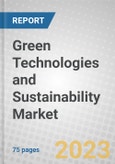This report has segmented the market based on technology type, industry, and geography. The report provides an overview of the global green technology and sustainability market and analyzes market trends. Using 2022 as the base year, the report provides estimated market data for the forecast period from 2023 to 2028. Revenue forecasts for this period are segmented by technology type, industry, and geography. Market values have been estimated based on the total revenue of green technology and sustainability solution providers.
The report covers the market for green technology with regard to the user base across different regions. It also highlights major trends and challenges that affect the market and the vendor landscape. The report estimates the global market for green technology in 2022 and provides projections for the expected market size through 2028.
Report Includes
- An overview of the global markets for green technologies and sustainability
- Estimation of market size and analyses of global market trends, with data from 2022, estimates for 2023, 2024, 2027, and projections of compound annual growth rates (CAGRs) through 2028
- Coverage of innovative and fascinating cutting-edge startups and businesses which are environmentally friendly and creating amazing green technology solutions
- Explanation of the major drivers, restraints and opportunities, competitive landscape, and current trends of the green technology and sustainability market
- Detailed analysis of the regulatory framework and policies and technological changes within the industry
- Market share analysis of the key companies of the industry and coverage of their proprietary technologies, strategic alliances, and other key market strategies and a relevant patent analysis
- Comprehensive company profiles of the leading players of the industry
Table of Contents
Executive Summary
Technology that is referred to as “green tech” is one that is thought to be ecologically benign in terms of its manufacturing or supply chain. The term green tech, which is an acronym for green technology, also covers the use of alternative fuels, the creation of clean energy, and various technologies that are less damaging to the environment than fossil fuels. The market for green technology is still relatively new, but because more people are becoming aware of the effects of climate change and the depletion of natural resources, it has attracted a lot of investment interest.
Protecting the environment, repairing environmental harm from the past, and preserving the natural resources of the planet are the objectives of green technology. Green technology is a booming business that has drawn significant sums of financial capital. The use of green technology may be a company or industry target. Green technology objectives are frequently included in an organization’s environmental, social and governance (ESG) statement or even in the mission statement of a company. Socially conscious investors are increasingly trying to focus their potential investments to include only businesses that use or create green technologies.
Green technology lowers costs by enhancing product design, reducing waste, reducing carbon footprint, and improving business efficiency; it also generates new job opportunities. Green technology increases quality of life while reducing negative effects on the environment and lowering expenses when compared to older technologies.
Sustainability has become an essential component of contemporary enterprises that no business can afford to ignore as the globe struggles with the environmental repercussions of human activity. Today’s clients, shareholders and employees want ethical behavior towards the environment and society. Companies must put sustainability at the top of their lists of priorities if they want to win over stakeholders’ trust and loyalty. Similarly, steps are being taken by governments and international organizations to cut carbon emissions. Businesses therefore must contribute by reducing the carbon footprint of their daily operations, distribution networks, and resource consumption.
The United Nations (UN) has several projects to help actors in national innovation systems create and use technology for more productive and sustainable activity. The Technology Facilitation Mechanism created by the 2030 Agenda for Sustainable Development has facilitated collaboration and partnerships in science, technology and innovation for sustainable development. The UN system aids nations in putting multilateral environmental agreements into effect by providing the necessary funding.
Corporate social responsibility programs have developed to put a stronger emphasis on sustainability. For instance, Google asserts that the Google Maps eco-routing tool has helped to dramatically cut greenhouse gas emissions. Google’s strategy for combating climate change includes educating consumers to make wiser decisions, decarbonizing its supply chain and operations, and leveraging technology to assist companies and towns in calculating their carbon footprints.
Companies Mentioned
- Cority
- Enablon (Wolters Kluwer)
- Engie Impact
- General Electric
- Ibm
- Intelex Technologies
- Minesense Technologies Ltd.
- Processmap
- Salesforce Inc.
- Schneider Electric








